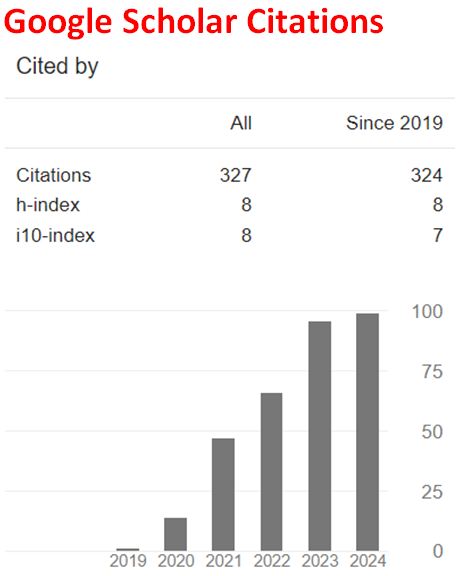DFT treatment of some isomers of griseofulvin
Abstract
Griseofulvin is an antifungal agent and is used to treat skin infections, fungal infections of the scalp, fingernails, and toenails etc. In the present study, various stereo/regio isomers of griseofulvin have been investigated within the constraints of density functional theory (DFT) at the levels of B3LYP/6-31+G(d,p) and partly B3LYP/6-31++G(d,p). All the isomers presently considered (in vacuum conditions) have exothermic heat of formation values and also possess favorable Gibbs free energy of formation values. In addition to that they are electronically stable structures. Various quantum chemical data have been collected and discussed including the HOMO, LUMO energies, and IR and UV-VIS spectra.
References
Egorov, N.S. (1980). Antibiotics, a scientific approach. Moscow: Mir Pub.
Sheklakov, N.D., & Milich, M.V. (1974). Mycoses in man. Moscow: Mir Pub.
De Carli, L., & Larizza, L. (1988). Griseofulvin. Mutation Research/Reviews in Genetic Toxicology, 195(2), 91-126.
Asger, B., Mads, H.R., Thomas O.L., & Mads, H.C. (2014). The chemistry of griseofulvin. Chem. Rev., 11(24), 12088-12107. https://doi.org/10.1021/cr400368e
Mustafa, A. (1974). Chemistry of heterocyclic compounds (Vol. 29, pp. 370-430). New York: John Wiley and Sons.
Aris, P., Wei, Y., Mohamadzadeh, M., & Xia, X. (2022). Griseofulvin: an updated overview of old and current knowledge. Molecules, 27, 7034. https://doi.org/10.3390/molecules27207034
Oxford, A.E., Raistrick, H., & Simonart, P. (1939). Studies in the biochemistry of micro-organisms: Griseofulvin, C17H17O6Cl, a metabolic product of Penicillium griseofulvum Dierckx. Biochem. J., 33, 240-248. https://doi.org/10.1042/bj0330240
Mac Millan, J. J. (1953). Griseofulvin. Part VII. Dechlorogriseofulvin. Chem. Soc., 1697-1702. https://doi.org/10.1039/JR9530001697
Develoux, M. (2001). Griseofulvin. Annales de dermatologie et de venereologie, 128(12), 1317-1325.
Cáceres-Ríos, H., Rueda, M., Ballona, R., & Bustamante, B. (2000). Comparison of terbinafine and griseofulvin in the treatment of tinea capitis. Journal of the American Academy of Dermatology, 42(1), Part 1, 80-84. https://doi.org/10.1016/S0190-9622(00)90013-6
Tey, H.L., Tan, A.S.L., & Chan, Y.C. (2011). Meta-analysis of randomized, controlled trials comparing griseofulvin and terbinafine in the treatment of tinea capitis. Journal of the American Academy of Dermatology, 64(4), 663-670. https://doi.org/10.1016/j.jaad.2010.02.048
Aggarwal, N., Goindi, S., & Khurana, R. (2013). Formulation, characterization and evaluation of an optimized microemulsion formulation of griseofulvin for topical application, Colloids and Surfaces B: Biointerfaces, 105, 158-166. https://doi.org/10.1016/j.colsurfb.2013.01.004
Gupta, A.K., Williams, J.V., Zaman, M., & Singh, J. (2009). In vitro pharmacodynamic characteristics of griseofulvin against dermatophyte isolates of Trichophyton tonsurans from tinea capitis patients. Medical Mycology, 47(8), 796-801. https://doi.org/10.3109/13693780802712523
Zhong, N., Chen, H., Zhao, Q., Wang, H., Yu, X., Eaves, A.M., Sheng, W., Miao, J., Cui, F., & Wang, J. (2010). Effects of griseofulvin on apoptosis through caspase-3- and caspase-9-dependent pathways in K562 leukemia cells: an in vitro study. Current Therapeutic Research, 71(6), 384-397. https://doi.org/10.1016/S0011-393X(10)80004-9
Bai, Y-B., Gao, Y-Q., Nie, X-D., Tuong, T-M-L., Li, D., & Gao, J-M. (2019). Antifungal activity of griseofulvin derivatives against phytopathogenic fungi in vitro and in vivo and three-dimensional quantitative structure-activity relationship. Analysis Journal of Agricultural and Food Chemistry, 67 (22), 6125-6132. https://doi.org/10.1021/acs.jafc.9b00606
Paguigan, N.D., Al-Huniti, M.H., Raja, H.A., Czarnecki, A., Burdette, J.E., González-Medina, M., Medina-Franco, J.L., Polyak, S.J., Pearce, C.J., Croatt, M.P., & Oberlies, N.H. (2017). Chemoselective fluorination and chemoinformatic analysis of griseofulvin: natural vs fluorinated fungal metabolites. Bioorganic & Medicinal Chemistry, 25(20), 5238-5246. https://doi.org/10.1016/j.bmc.2017.07.041
Mahmoud, W.H., Mahmoud, N.F., & Mohamed, G.G. (2018). Synthesis, characterization, density functional theory, X-ray study, thermal stability, and biological and MOE relevance of metal complexes of griseofulvin. Applied Organometalic Chemistry, 32(5), e4312 . https://doi.org/10.1002/aoc.4312
Knoblauch, J., & Zimmermann, I. (2007). Thermochemical analysis of the dissolution process of Griseofulvin. European Journal of Pharmaceutics and Biopharmaceutics, 67(3), 743-751. https://doi.org/10.1016/j.ejpb.2007.04.012
Lässer, J., & Braun, D.E.( 2025). Exploring coformer substitution in cocrystallization: griseofulvin and phenol derivatives. Crystal Growth & Design, 25(5), 1688-1707. https://doi.org/10.1021/acs.cgd.5c00065
Das, S., & Sandip, P. (2016). Computer simulation studies of the mechanism of hydrotrope-assisted solubilization of a sparingly soluble drug molecule. The Journal of Physical Chemistry B, 120(14), 3540-3550. https://doi.org/10.1021/acs.jpcb.5b11902
Stewart, J.J.P. (1989). Optimization of parameters for semi-empirical methods I. J. Comput. Chem., 10, 209-220. https://doi.org/10.1002/jcc.540100208
Stewart, J.J.P. (1989). Optimization of parameters for semi-empirical methods II. J. Comput. Chem., 10, 221-264. https://doi.org/10.1002/jcc.540100209
Leach, A.R. (1997). Molecular modeling. Essex: Longman.
Kohn, W., & Sham, L.J. (1965). Self-consistent equations including exchange and correlation effects. Phys. Rev., 140, 1133-1138. https://doi.org/10.1103/PhysRev.140.A1133
Parr, R.G., & Yang, W. (1989). Density functional theory of atoms and molecules. London: Oxford University Press.
Becke, A.D. (1988). Density-functional exchange-energy approximation with correct asymptotic behavior. Phys. Rev. A, 38, 3098-3100. https://doi.org/10.1103/PhysRevA.38.3098
Vosko, S.H., Wilk, L., & Nusair, M. (1980). Accurate spin-dependent electron liquid correlation energies for local spin density calculations: a critical analysis. Can. J. Phys., 58, 1200-1211. https://doi.org/10.1139/p80-159
Lee, C., Yang, W., & Parr, R.G. (1988). Development of the Colle-Salvetti correlation energy formula into a functional of the electron density. Phys. Rev. B, 37, 785-789. https://doi.org/10.1103/PhysRevB.37.785
SPARTAN 06 (2006). Wavefunction Inc. Irvine CA, USA.

This work is licensed under a Creative Commons Attribution 4.0 International License.


